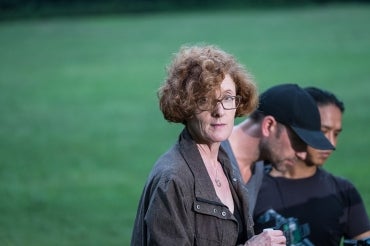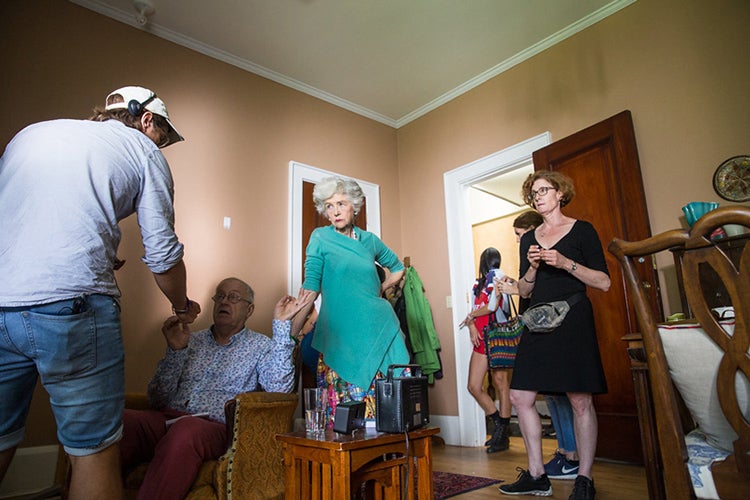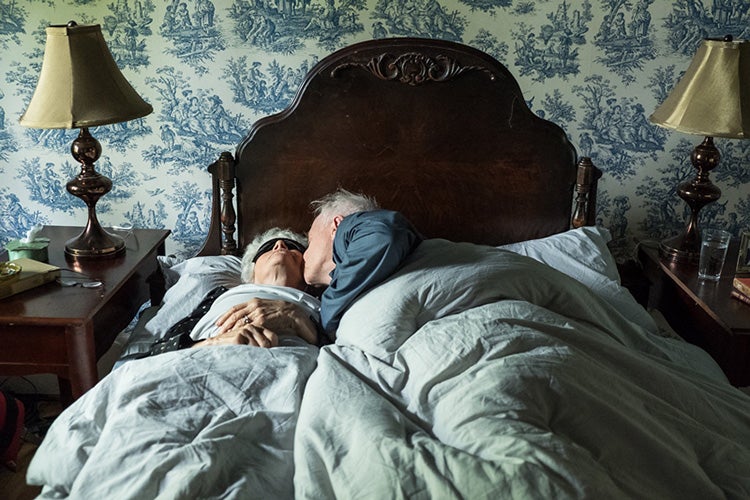U of T professor brings Atwood short story to the screen to spur discussion on sight loss

Published: August 29, 2018
It opens in an ophthalmologist’s office. A series of shots show medical equipment used to treat eye conditions. The camera cuts to a closeup of a man’s face as he receives the news.
“It's called age-related macular degeneration,” he hears. “I'm sorry. And, Frank, some people with vision loss start to see things. Don't worry, you can tell what's real and what isn't.”
This is the opening scene of Torching the Dusties, a short film co-written and co-directed by Marlene Goldman, an internationally recognized professor in the English department at the University of Toronto Scarborough, and Philip McKee, a Toronto-based theatre and film director. The 10-minute film, based on Margaret Atwood’s short story of the same name, is scheduled for release in December.
“My goal as an age studies scholar is to reduce the shame associated with age-related changes,” says Goldman. “And to make people more comfortable discussing some of these experiences.”
Age-related macular degeneration damages the part of the retina responsible for perceiving fine details. Frank later experiences Charles Bonnet syndrome, a condition common among people with sight loss characterized by visual hallucinations.
Goldman says people with Charles Bonnet syndrome are often reluctant to talk about symptoms for fear of being misdiagnosed with dementia and other forms of mental illness. The condition is underrepresented in media, she adds.

Filming at U of T Scarborough's Miller Lash House – Professor Marlene Goldman is at right (photo by Robin Cymbaly)
The film was shot entirely at U of T Scarborough’s Miller Lash House. The house was transformed into Ambrosia Manor, a retirement community targeted by Our Turn, a vigilante group whose solution to an economic downturn is to burn down nursing homes.
Apocalyptic responses to intergenerational tensions are a pattern Goldman has noticed in Canadian literature.
“I want to use the film as a platform to have overarching general discussions about this negative pattern which pits the generations against one another,” Goldman says.
“As the demographic in Canada changes due to aging baby boomers, we need to think carefully about adopting that unfortunate and impoverished way of approaching social problems that creates and support divisions rather than collaboration.”

The vigilante scene in Torching The Dusties (photo by Robin Cymbaly)
To tell an accurate, “people-centric” story, Goldman worked with clinicians with experience in macular degeneration and patients with sight loss.. She also collaborated with Jessica Watkins, a PhD student at U of T’s Centre for Theatre, Drama, and Performance Studies, who consulted on the screenplay and location and helped create audio description for the film.
“She really helped us wrap our heads around how we can make a film accessible and beautiful for people who have sight loss,” Goldman says.
The film was funded by the Canadian National Institute for the Blind’s (CNIB) Barbara Tuck MacPhee research grant, a $25,000 award that supports researchers working in macular degeneration. Goldman is the first arts-based researcher to receive the award.
Mahadeo Sukhai, head of research and chief accessibility officer at the CNIB and a U of T alumnus, decided this year to allow grant applications outside of the traditional medical field.
“There are so few films, there are so few plays, there are so few pieces of work that really relate to sight loss,” Sukhai says. “There are so few things that can put sight loss in the public consciousness in an effective and efficient way.
“I personally believe this will be one of those pieces.”

“My goal as an age studies scholar is to reduce the shame associated with age-related changes,” says Goldman (photo by Robin Cymbaly)
Sukhai says the project could have wide-reaching impacts on medical communities as well. It could be an important training tool for professionals, including CNIB’s own staff, to understand the experiences of patients, he says.
“We’re hoping for the opportunity to really impact how people perceive sight loss, and the recognition that sight loss isn’t a life-ending situation,” Sukhai says. “You can live an effective, a good, a participatory and full life regardless.”
Goldman says she feels it is time for people to understand the benefits of arts and arts-based research.
“I think there’s an incredible way that the arts complement sciences and biomedicine because the arts speak to people’s personal and ordinary experiences and bring a great deal of joy,” she says.



